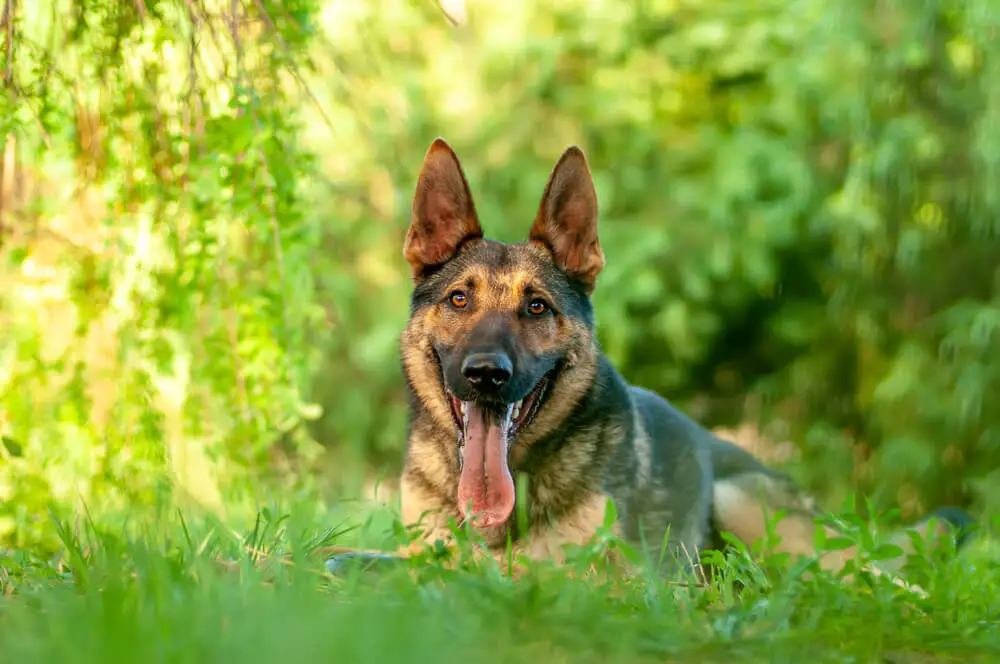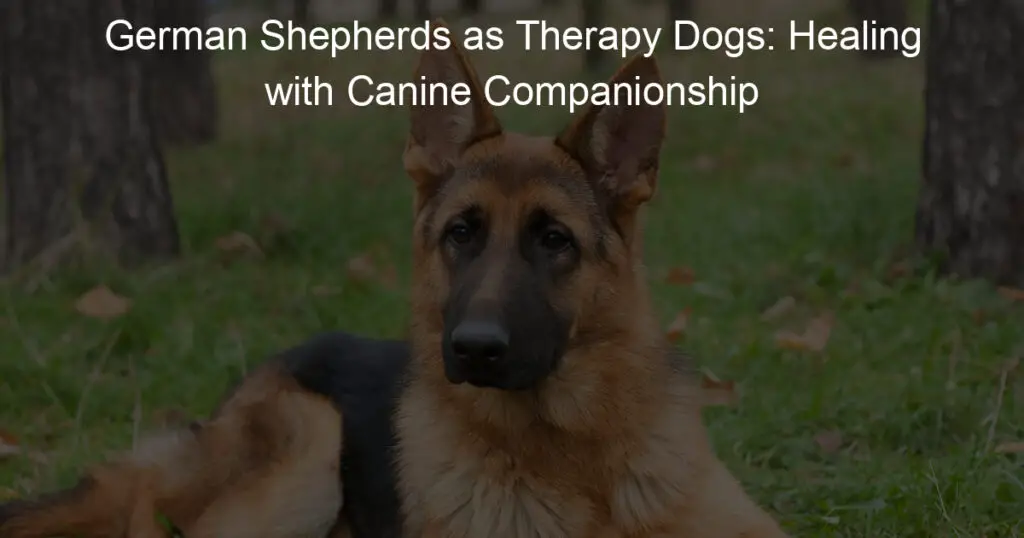The Czech German Shepherd, also known as the Czechoslovakian Shepherd, originated from the Czech border and has been bred for its exceptional working abilities since 1955. These dogs gained popularity after the merging of East and West Germany in 1989.
Known for their larger size compared to other German Shepherd breeds, they serve as loyal companions and skilled working dogs in various roles, including police and military service, search and rescue, and as family pets.
This hardworking breed has a strong, muscular build with a thick head, upright pointed ears, and a medium-length, dense coat.
The Czech German Shepherd is highly trainable and intelligent, making it well-suited for challenging tasks and active families.
However, potential owners should be aware of some health concerns associated with the breed, including hip and elbow dysplasia, and take necessary precautions for their care and well-being.
Key Takeaways
- Czech German Shepherds are larger and primarily bred for working roles, gaining popularity after the reunification of Germany.
- This breed is highly trainable and intelligent, often used for police and military service, search and rescue, and as family pets.
- Prospective owners should be aware of potential health concerns like hip and elbow dysplasia and learn about proper care and maintenance for the breed.
The Czech German Shepherds

Czech German Shepherds originated from Czechoslovakia and can be traced back to the 14th century. However, they were not professionally bred until 1955 in communist Czechoslovakia.
Initially, the Czech army found these dogs to be excellent servants, showcasing their muscular build and intelligence.
In the Czech Republic, German Shepherds were first bred in 1895, and since then, they have become one of the most popular dog breeds in the world.
Historically, the breeding of German Shepherd Dogs in the Czech Republic predominantly focused on working dogs, catering to the needs of their communist government before the 1989 revolution.
The Czech Shepherd is a mix of Czech border dogs and DDR German Shepherds, the latter of which played a significant role in Germany’s history as part of the World War and was known as the best border dog.
DDR German Shepherd is now considered a rare breed.
Now that you have a brief understanding of the history of Czech German Shepherds, it’s essential to appreciate their historical and cultural significance, as well as their development as a unique dog breed.
Characteristics of Czech German Shepherds

Physical Attributes
Czech German Shepherds are a robust and muscular breed originating from the Czech Republic. They usually have a medium-length, wavy double coat with black and tan coloring.
As for their size, females typically stand between 19.3 to 20.5 inches, while males stand at 20.5 to 21.7 inches. Weight varies from 37 to 53 pounds for females and 41 to 60 pounds for males.
Temperament
The temperament of Czech German Shepherds is notably friendly, active, and intelligent. Being bred to work closely with humans, they naturally crave companionship and form strong bonds with their human family.
These dogs are known for their loyalty, high energy levels, and eagerness to learn and take on various tasks.
Life Span
You can expect your Czech German Shepherd to have a life span of about 12 to 15 years.
As with any breed, maintaining a healthy lifestyle, providing proper nutrition, having regular veterinary check-ups, and engaging in regular exercise and mental stimulation are essential factors to ensure a long and healthy life for your dog.
Training Czech German Shepherds

When training your Czech German Shepherd, it’s essential to focus on two key aspects: obedience training and protection training.
These intelligent and energetic dogs require consistent, clear, and positive reinforcement to thrive and become well-behaved family companions or working dogs.
Obedience Training
Start obedience training with your Czech German Shepherd early, preferably when they are a puppy. Consistency is crucial when teaching basic commands like sit, stay, come, and heel.
Use positive reinforcement techniques like treats, praise, and playtime to reward your dog for following commands.
Be patient and firm, but never use harsh techniques, as they may negatively affect the dog’s confidence and trust in you.
Tips for successful obedience training:
- Establish a routine with regular training sessions
- Keep sessions short (15-20 minutes) to maintain your dog’s focus
- Practice commands in different environments to reinforce learning
Protection Training
Czech German Shepherds have a natural instinct to protect their family and territory. However, proper protection training is essential to ensure that your dog becomes a reliable and controlled guardian.
It’s best to consult with a professional dog trainer who has experience in protection training for working breeds like the Czech German Shepherd.
During protection training, the emphasis should be on developing the dog’s confidence, courage, and self-control.
Your Czech German Shepherd will learn to assess threats and respond appropriately, only using force when necessary.
This is achieved through specialized exercises, like bite work and threat detection training.
Remember to establish a clear and consistent communication system to signal when it’s time for your dog to switch from a friendly, social mode to a protection mode.
Paying attention to these aspects of training will help to shape your Czech German Shepherd into a highly obedient and capable working or family pet.
Health Concerns of Czech German Shepherds

Common Health Issues
Just like any other breed, Czech German Shepherds can face certain health issues that you need to be aware of. These include hip dysplasia, elbow dysplasia, degenerative myelopathy, and gastric torsion (bloat).
- Hip dysplasia is a genetic condition where the hip joint doesn’t develop properly, leading to arthritis and pain. It is important to get regular checkups and maintain a healthy weight for your dog to mitigate this issue.
- Elbow dysplasia is another joint issue that can affect this breed, which involves abnormal development of the elbow joint. This can cause pain and lameness in the affected limb.
- Degenerative myelopathy is a progressive neurological disease that affects the spinal cord. It usually occurs in older dogs and can lead to paralysis. Early detection is crucial, so look out for any signs of weakness or difficulty in movement.
- Gastric torsion (bloat) is a life-threatening condition in which the stomach fills with gas and twists on itself. It is important to prevent your dog from eating too fast or excessively exercising after a meal to reduce the risk of this issue.
Preventive Measures
To maintain the health of your Czech German Shepherd, here are some preventive measures you should take:
- Provide a proper diet that is rich in nutrients and balanced for its specific needs.
- Make sure your dog gets regular exercise to maintain a healthy weight and prevent joint issues.
- Schedule regular check-ups with the veterinarian to detect any health issues early on.
- Consider getting genetic testing done to identify any potential hereditary health risks.
Veterinary Care
In addition to the preventive measures mentioned above, be proactive in seeking veterinary care for your Czech German Shepherd.
Regular visits to the vet ensure early diagnosis and treatment of any health issues that may arise. Don’t hesitate to consult with your veterinarian if you notice any unusual changes in behavior, appetite, or energy levels.
Dental care is also crucial for maintaining your dog’s overall health, so make sure to include it as a part of their routine care.
Caring for Czech German Shepherds

Feeding
Feeding your Czech German Shepherd a balanced and nutritious diet is essential for maintaining their health and energy levels.
Generally, adult Czech German Shepherds should be fed 2-3 cups of high-quality dry dog food per day, divided into two meals.
Remember to adjust the amount of food based on your dog’s size, activity level, and age.
- Puppies: Feed them specially formulated puppy food until they’re about a year old.
- Adults: Gradually transition them to adult dog food, keeping an eye on any sensitivities or dietary needs.
- Seniors: Older Czech German Shepherds may require a lower-calorie diet to maintain a healthy weight.
Always provide fresh water for your dog and avoid overfeeding to prevent obesity and health issues.
Exercise Requirement
Czech German Shepherds are active dogs that require regular exercise to stay healthy and mentally stimulated.
Plan to provide at least 1-2 hours of physical activity each day, which can include:
- Walks: Take your Czech German Shepherd on daily long walks or hikes, maintaining a brisk pace to keep them engaged.
- Playtime: Engage in interactive games such as fetch, frisbee, or tug-of-war to give your dog a workout.
- Mental stimulation: Incorporate training exercises, puzzle toys, and scent work to challenge their intelligence and focus.
Remember to always provide a safe, enclosed space for off-leash play, and avoid exercising your dog during extreme temperatures.
Grooming
Czech German Shepherds have a medium-length, wavy double coat that requires regular grooming to keep it healthy and clean. Here are some essential grooming tasks:
- Brushing: Brush your dog’s coat at least once a week using a slicker brush to remove loose hair and prevent matting.
- Bathing: Bathe your Czech German Shepherd every 1-2 months, or as needed, using a gentle dog shampoo.
- Nail trimming: Trim their nails every 3-4 weeks or when you hear them clicking on the floor.
- Ear cleaning: Check and clean your dog’s ears weekly with a dog-safe ear cleaner to prevent infections.
- Dental care: Brush your Czech German Shepherd’s teeth regularly using a dog toothbrush and toothpaste to maintain good oral hygiene.
Maintaining a regular grooming routine will help keep your Czech German Shepherd looking and feeling their best.
Breed Recognition

The Czech German Shepherd is an extraordinary breed known for its tenacity, strength, and powerful appearance. As a dog enthusiast, you might be interested in this breed’s recognition among the canine community.
Czech German Shepherds are often considered an offshoot or a part of the East German Shepherd breed. Originating in the Czech Republic when it was a part of the U.S.S.R., they were initially used as border guard dogs in the 1950s.
However, despite their close association with the German Shepherd breed, they have their own unique traits that set them apart.
To distinguish them from the ordinary German Shepherd, pay attention to their physical characteristics.
Czech German Shepherds are larger, with males reaching up to 68 pounds and females weighing between 49 to 71 pounds, and they have the typical facial appearance of a strong jaw, thick head, and upright pointed ears.
In addition, they often have a more compact build, making them visually distinctive.
While Czech German Shepherds’ pedigree may seem like it would lead to immediate recognition, it’s essential to understand that their official recognition varies.
With some canine organizations recognizing them, others still see them as a part of the overall German Shepherd breed.
As you explore and appreciate the impressive qualities of Czech German Shepherds, understanding their breed recognition will help you advocate for their uniqueness and inform others about the fascinating history and characteristics that make this breed truly distinctive.
Adopting Czech German Shepherd Puppies

When considering adopting a Czech German Shepherd puppy, it’s essential to understand their origin and unique characteristics.
Czech German Shepherds, or Czechoslovakian Shepherds, were initially bred as working dogs in the Communist Czech during 1955.
These dogs have a strong working bloodline, making them intelligent, loyal, and highly trainable.
Before starting your search for a Czech German Shepherd puppy, make sure you have adequate space and time to provide a stimulating environment.
These dogs require consistent mental and physical exercise, as well as socialization with other dogs and humans.
A fenced yard and plenty of time for training, exercise, and play are essential for a happy and healthy Czech German Shepherd.
When searching for a reputable breeder, look for those who specialize in Czech, Slovak, and West German working bloodlines, like Czech Working Dogs in Texas.
A good breeder will be knowledgeable about the breed and will prioritize the puppies’ health, temperament, and overall well-being.
Do not be afraid to ask questions about parentage, health testing, and temperament evaluations to ensure you are adopting a puppy that will become a well-rounded adult dog.
Once you have found a potential breeder, make a visit to their facility. Pay attention to the living conditions, cleanliness, and behavior of the dogs.
A well-maintained facility and well-socialized dogs are indicators of a responsible breeder. Do not hesitate to walk away if you have concerns about the breeder’s practices or the puppies’ health.
Upon adopting a Czech German Shepherd puppy, be prepared for a long-term commitment to their training and care.
These intelligent dogs will thrive with consistent training, socialization, and positive reinforcement.
Engaging in activities like obedience, agility, or herding can build a strong bond between you and your dog while catering to their natural instincts.
In summary, adopting a Czech German Shepherd puppy is a rewarding and life-changing experience.
By doing thorough research, finding a responsible breeder, and investing time and effort in proper training, you’ll provide a loving home for a loyal and intelligent companion.
Role of Czech German Shepherds

In-Home
Czech German Shepherds, known for their strength and intelligence, can be excellent family pets. They are naturally protective and form strong bonds with their humans, creating a secure environment in your home.
Due to their high energy levels and intelligence, it’s essential that you provide them with mental and physical stimulation to keep them engaged and happy.
When it comes to training, be consistent and positive. Czech German Shepherds respond well to reward-based training methods and can quickly learn commands.
Socializing them from the start is crucial to ensure they become well-rounded and adaptable members of your family.
In Work
Czech German Shepherds excel in various working roles due to their agility, strength, and intelligence.
Historically, they were used by border guards in the Czech Republic, proving their effectiveness as protective and versatile working dogs.
Today, they continue to serve in law enforcement, search, and rescue operations, and as service dogs for individuals with disabilities.
One notable aspect of their work capabilities is their keen sense of smell, which allows them to excel in scent detection tasks.
Their endurance also makes them suitable for tasks that require stamina and perseverance.
Czech German Shepherds are versatile and dedicated dogs that can adapt to various roles within both homes and the workplace.
Providing them with proper training, socialization, and mental and physical stimulation will help them thrive and reach their full potential.
Frequently Asked Questions
What are the key differences between Czech and German Shepherds?
Czech German Shepherds are typically more muscular and have darker coats compared to their German counterparts.
While both breeds share similar traits, Czech Shepherds are known for their strong working drive and ability to excel in various tasks.
German Shepherds, on the other hand, can be more diverse in their appearance and temperament because they have been bred for both working and show lines.
How much does a Czech German Shepherd typically cost?
The cost of a Czech German Shepherd can vary depending on factors such as the breeder, bloodline, and availability.
Generally, you can expect to pay anywhere between $1,000 and $3,000 for a Czech German Shepherd from a reputable breeder.
What are the characteristics of the Black Czech German Shepherd?
The Black Czech German Shepherd is known for its dark, sable coat, and muscular build.
This variant of the Czech German Shepherd is often bred for its strong working ability, making it a popular choice for roles in law enforcement, military, and search and rescue.
Are Czech German Shepherds commonly used in working line roles?
Yes, Czech German Shepherds are often used in working line roles due to their high drive, intelligence, and versatile skill set.
They excel in tasks such as herding, search and rescue, protection, and detection. Their strong work ethic, combined with their physical abilities, make them a popular choice for professionals in these fields.
What is the average weight of a Czech German Shepherd?
The average weight of a Czech German Shepherd ranges from 60 to 90 pounds, with males typically weighing between 65 and 90 pounds and females weighing between 60 and 80 pounds.
Their weight can be influenced by factors such as genetics, diet, and exercise.
What were Czech German Shepherds originally bred for?
Czech German Shepherds were originally bred for their working abilities in communist Czechoslovakia, where they served as border patrol dogs to detect and apprehend people attempting to cross the border illegally.
Their intelligence, strength, and loyalty made them an excellent choice for this role.















